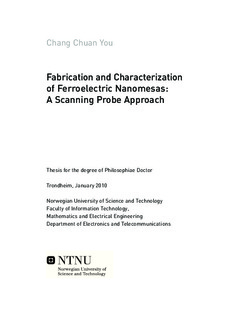| dc.contributor.author | You, Chang Chuan | nb_NO |
| dc.date.accessioned | 2014-12-19T13:42:49Z | |
| dc.date.accessioned | 2015-12-22T11:40:06Z | |
| dc.date.available | 2014-12-19T13:42:49Z | |
| dc.date.available | 2015-12-22T11:40:06Z | |
| dc.date.created | 2010-03-19 | nb_NO |
| dc.date.issued | 2010 | nb_NO |
| dc.identifier | 304786 | nb_NO |
| dc.identifier.isbn | 978-82-471-1954-9 (printed ver.) | nb_NO |
| dc.identifier.isbn | 978-82-471-1955-6 (electronic ver.) | |
| dc.identifier.uri | http://hdl.handle.net/11250/2368878 | |
| dc.description.abstract | The present study focuses on experimental investigations of size effects in ferroelectric perovskite nanostructures. When the size of a ferroelectric material is reduced down to the nanoscale, its physical properties are expected to differ considerably from the bulk properties. In order to address size effects, we have developed a novel fabrication scheme which allows us to define sub-50 nm ferroelectric PbTiO3 nanomesas on prestructured SrRuO3 templates, grown on SrTiO3 substrates.
The SrRuO3 templates were prepared using a top-down lithography technique based on scanning tunneling microscopy (STM). Surface modifications through STM line etching of SrRuO3 thin films have been carried out in order to establish the etching process in a controllable and reproducible fashion. From these line etching experiments, we observed that an applied bias voltage above a threshold value was necessary for successful line etching. Moreover, the line etching was found to depend on both bias voltage and scan speed for a fixed number of scans. The depth of the etched lines increases with increasing bias voltage and scan repetitions as well as with decreasing scan speed.
The PbTiO3 nanomesas were deposited on the nanostructured SrRuO3 templates using an off-axis radio frequency magnetron sputtering technique. The as-grown PbTiO3 nanomesas had a lateral size and a thickness down to ~ 30 nm and ~ 4 nm, respectively. Piezoresponse force microscopy measurements for the 4 nm thick PbTiO3 nanomesas showed that the piezoelectric response increases strongly as the lateral size was reduced from ~ 120 nm down to 30 nm. For the same lateral size range, a reduction of the coercive voltage was also observed. The laterally size-dependent behavior is attributed to the reduction of in-plane strain, imposed on the mesa structure by the substrate, when shrinking the lateral dimensions of the nanomesas. In addition, it was found that the PbTiO3 nanomesas had a polydomain structure, similar to that observed in the as-grown, surrounding, homogeneous PbTiO3 thin film. | nb_NO |
| dc.language | eng | nb_NO |
| dc.publisher | Norges teknisk-naturvitenskapelige universitet, Fakultet for informasjonsteknologi, matematikk og elektroteknikk, Institutt for elektronikk og telekommunikasjon | nb_NO |
| dc.relation.ispartofseries | Doktoravhandlinger ved NTNU, 1503-8181; 2010:4 | nb_NO |
| dc.relation.haspart | You, Chang Chuan. Nanoscale structuring of SrRuO<sub>3</sub> thin film surfaces by scanning tunneling microscopy . Applied Surface Science. (ISSN 0169-4332). 253(10): 4704-4708, 2007. <a href='http://dx.doi.org/10.1016/j.apsusc.2006.10.030'>10.1016/j.apsusc.2006.10.030</a>. | nb_NO |
| dc.relation.haspart | You, Chang Chuan; Takahashi, Ryota; Borg, Anne; Grepstad, Jostein K.; Tybell, Thomas. The fabrication and characterization of PbTiO<sub>3</sub> nanomesas realized on nanostructured SrRuO<sub>3</sub>/SrTiO<sub>3</sub> templates. Nanotechnology. (ISSN 0957-4484). 20(25): 255705, 2009. <a href='http://dx.doi.org/10.1088/0957-4484/20/25/255705'>10.1088/0957-4484/20/25/255705</a>. | |
| dc.title | Fabrication and Characterization of Ferroelectric Nanomesas: A Scanning Probe Approach | nb_NO |
| dc.type | Doctoral thesis | nb_NO |
| dc.contributor.department | Norges teknisk-naturvitenskapelige universitet, Fakultet for informasjonsteknologi, matematikk og elektroteknikk, Institutt for elektronikk og telekommunikasjon | nb_NO |
| dc.description.degree | PhD i informasjons- og kommunikasjonsteknologi | nb_NO |
| dc.description.degree | PhD in Information and Communications Technology | |
